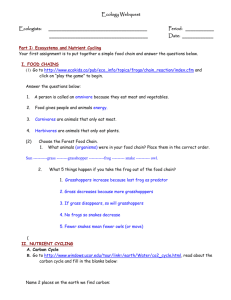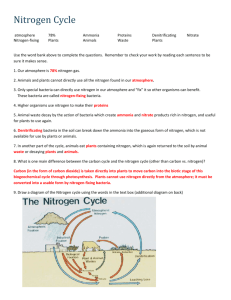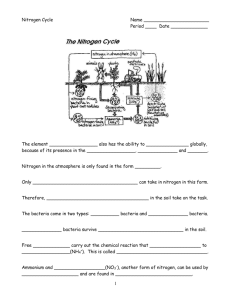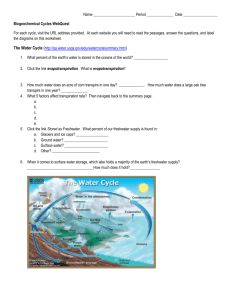File
advertisement
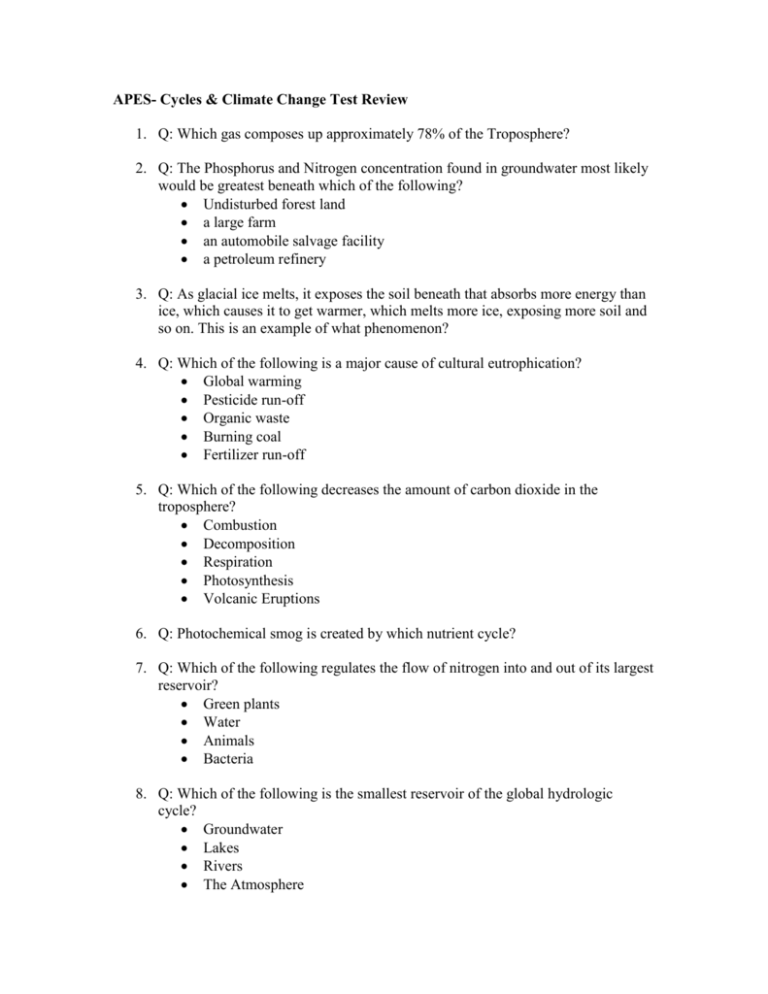
APES- Cycles & Climate Change Test Review 1. Q: Which gas composes up approximately 78% of the Troposphere? 2. Q: The Phosphorus and Nitrogen concentration found in groundwater most likely would be greatest beneath which of the following? Undisturbed forest land a large farm an automobile salvage facility a petroleum refinery 3. Q: As glacial ice melts, it exposes the soil beneath that absorbs more energy than ice, which causes it to get warmer, which melts more ice, exposing more soil and so on. This is an example of what phenomenon? 4. Q: Which of the following is a major cause of cultural eutrophication? Global warming Pesticide run-off Organic waste Burning coal Fertilizer run-off 5. Q: Which of the following decreases the amount of carbon dioxide in the troposphere? Combustion Decomposition Respiration Photosynthesis Volcanic Eruptions 6. Q: Photochemical smog is created by which nutrient cycle? 7. Q: Which of the following regulates the flow of nitrogen into and out of its largest reservoir? Green plants Water Animals Bacteria 8. Q: Which of the following is the smallest reservoir of the global hydrologic cycle? Groundwater Lakes Rivers The Atmosphere Polar Ice Caps/Glaciers 9. Q: Nitrogen fixation will take place in fields that are planted with: Soy Corn Rice Potatoes Wheat 10. Q: Most photosynthesis in the open sea occurs in the: euphotic zones benthic zones littoral zone abyssal zone 11. Q: Which of the following would decrease one’s ecological footprint? traveling by airplane rather than driving eating more meat walking to school purchasing a larger home 12. Q: Which of the following is a correct sequence of transformation in the nitrogen cycle? transpiration- nitrification- assimilation- ammonification-respiration fixation- ammonification-nitrification- assimilation- denitrification ammonification-respiration-nitrification-denitrification fixation-nitrification-assimilation-ammonification 13. Q: Of the following, the largest storage reservoir of the world’s freshwater is: the atmosphere groundwater lakes living organisms rivers 14. Q: The major sink for phosphorus is: marine sediments atmospheric gases seawater plants 15. Q: In the nitrogen cycle, the bacteria that replenish the atmosphere with N2 are: Rhizobium nitrifying bacteria denitrifying bacteria nitrogen-fixing bacteria 16. Q: The largest user of freshwater worldwide is: mining irrigation industry home use 17. Q: Which of the following are trace elements necessary in the human diet? Ca, Mg, and Na Al and Fe I, Cu and Zn S, N and P C, H and O 18. Q: The concentration of which gas can be reduced by preventing forest depletion? Carbon Dioxide Nitrous Oxide Oxygen Methane 19. Q: The stage of the nitrogen cycle in which plant roots absorb ammonia, ammonium, and nitrate ions to manufacture DNA, amino acids, and proteins 20. Q: What is the chemical formula of ammonia? 21. Q: What is the current percentage of Carbon Dioxide in the atmosphere? 22. Q: Process in which nitrates are turned in nitrogen gas and nitrous oxide, which are then released back into the atmosphere 23. Q: Wearing away of the lands by running water, glaciers, winds and waves 24. Q: These plants belong to the pea or bean family and form a mutualistic association with certain species of bacteria (rhizobium) that allow the plant to absorb nitrogen in a usable form. 25. Q: Which element is commonly considered to be the limiting factor in plant growth? 26. Q: Nitrogen fixation can occur through the help of soil bacteria and legumes AND also through which other process? 27. Q: What is the process of plants losing water vapor through their leaves? 28. Q: The process by which excess nutrients are released into a body of water causing an overgrowth of algae that depletes the water of dissolved oxygen. 29. Q: Which of the nutrient cycles doesn’t have an atmospheric component? 30. Q: When the input and output of a system is equal, it is said to be in: 31. Q: Preserving the environment because it is beautiful, it which type of justification? 32. Q: What is the non-living parts of an ecosystem called? 33. Q: Which macronutrients are considered to be “The Big 6”?


